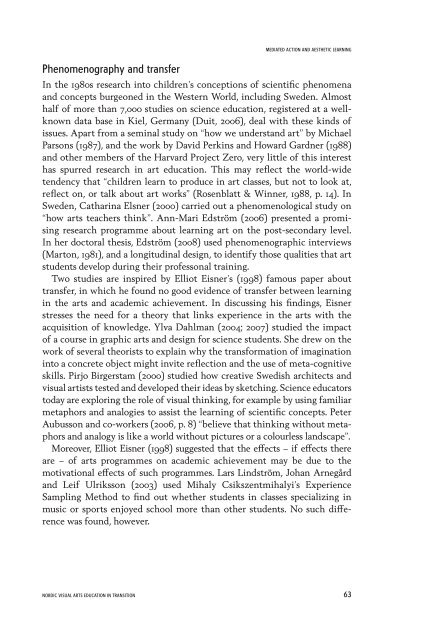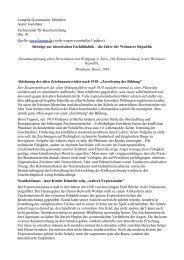Research in Visual Arts Education - The National Society for ...
Research in Visual Arts Education - The National Society for ...
Research in Visual Arts Education - The National Society for ...
You also want an ePaper? Increase the reach of your titles
YUMPU automatically turns print PDFs into web optimized ePapers that Google loves.
MEDIATED ACTION AND AESTHETIC LEARNING<br />
Phenomenography and transfer<br />
In the 1980s research <strong>in</strong>to children’s conceptions of scientific phenomena<br />
and concepts burgeoned <strong>in</strong> the Western World, <strong>in</strong>clud<strong>in</strong>g Sweden. Almost<br />
half of more than 7,000 studies on science education, registered at a wellknown<br />
data base <strong>in</strong> Kiel, Germany (Duit, 2006), deal with these k<strong>in</strong>ds of<br />
issues. Apart from a sem<strong>in</strong>al study on “how we understand art” by Michael<br />
Parsons (1987), and the work by David Perk<strong>in</strong>s and Howard Gardner (1988)<br />
and other members of the Harvard Project Zero, very little of this <strong>in</strong>terest<br />
has spurred research <strong>in</strong> art education. This may reflect the world-wide<br />
tendency that “children learn to produce <strong>in</strong> art classes, but not to look at,<br />
reflect on, or talk about art works” (Rosenblatt & W<strong>in</strong>ner, 1988, p. 14). In<br />
Sweden, Cathar<strong>in</strong>a Elsner (2000) carried out a phenomenological study on<br />
“how arts teachers th<strong>in</strong>k”. Ann-Mari Edström (2006) presented a promis<strong>in</strong>g<br />
research programme about learn<strong>in</strong>g art on the post-secondary level.<br />
In her doctoral thesis, Edström (2008) used pheno menographic <strong>in</strong>terviews<br />
(Marton, 1981), and a longitud<strong>in</strong>al design, to identify those qualities that art<br />
students develop dur<strong>in</strong>g their professonal tra<strong>in</strong><strong>in</strong>g.<br />
Two studies are <strong>in</strong>spired by Elliot Eisner’s (1998) famous paper about<br />
transfer, <strong>in</strong> which he found no good evidence of transfer between learn<strong>in</strong>g<br />
<strong>in</strong> the arts and academic achievement. In discuss<strong>in</strong>g his f<strong>in</strong>d<strong>in</strong>gs, Eisner<br />
stresses the need <strong>for</strong> a theory that l<strong>in</strong>ks experience <strong>in</strong> the arts with the<br />
acquisition of knowledge. Ylva Dahlman (2004; 2007) studied the impact<br />
of a course <strong>in</strong> graphic arts and design <strong>for</strong> science students. She drew on the<br />
work of several theorists to expla<strong>in</strong> why the trans<strong>for</strong>mation of imag<strong>in</strong>ation<br />
<strong>in</strong>to a concrete object might <strong>in</strong>vite reflection and the use of meta-cognitive<br />
skills. Pirjo Birgerstam (2000) studied how creative Swedish architects and<br />
visual artists tested and developed their ideas by sketch<strong>in</strong>g. Science educators<br />
today are explor<strong>in</strong>g the role of visual th<strong>in</strong>k<strong>in</strong>g, <strong>for</strong> example by us<strong>in</strong>g familiar<br />
meta phors and analogies to assist the learn<strong>in</strong>g of scientific concepts. Peter<br />
Aubusson and co-workers (2006, p. 8) “believe that th<strong>in</strong>k<strong>in</strong>g without metaphors<br />
and analogy is like a world without pictures or a colourless landscape”.<br />
Moreover, Elliot Eisner (1998) suggested that the effects – if effects there<br />
are – of arts programmes on academic achievement may be due to the<br />
motivational effects of such programmes. Lars L<strong>in</strong>dström, Johan Arnegård<br />
and Leif Ulriksson (2003) used Mihaly Csikszentmihalyi’s Experience<br />
Sampl<strong>in</strong>g Method to f<strong>in</strong>d out whether students <strong>in</strong> classes specializ<strong>in</strong>g <strong>in</strong><br />
music or sports enjoyed school more than other students. No such difference<br />
was found, however.<br />
NORDIC VISUAL ARTS EDUCATION IN TRANSITION 63



